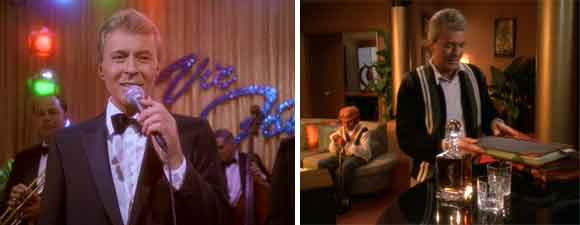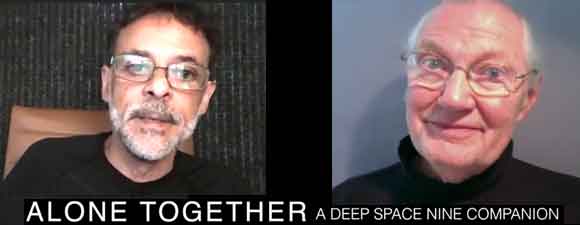Retro Review: The Reckoning
7 min readA Prophet and a Pah-Wraith from an ancient Bajoran artifact take over the bodies of Kira and Jake to wage an ancient war.
Plot Summary: Sisko is summoned to Bajor because an ancient stone tablet found beneath B’hala – the long-lost city he discovered in visions – mentions the Emissary. As soon as Sisko touches the object, the Prophets appear to him, declaring that the Reckoning must begin. When Sisko takes the tablet to the station for Dax to translate, Kai Winn comes to demand that he return it, though Sisko says that he will not return the artifact until he understands its message. Dax’s partial translation says that the sorrow of the Prophets will consume the gateway to the Temple, which she believes means Deep Space Nine. Soon after, the wormhole becomes unstable, creating quakes on Bajor and the station. Both Admiral Ross and First Minister Shakaar tell Sisko to surrender the object to Winn and he initially agrees, yet when Sisko asks the Prophets to clarify their wishes, he become frustrated at their silence, then smashes the tablet, releasing two vapor-like emissions. Winn is irate, but Sisko claims that he believes the Prophets intended him to shatter the tablet. Meanwhile, the station experiences a power drain. Sisko finds Kira standing before the Bajoran shrine possessed by a Prophet, who tells him that her body is willing to serve as a vessel, for the Reckoning is at hand. Winn recognizes a fragment of a Bajoran prophecy in which a Pah-wraith exiled from the Celestial Temple will return to do battle with a Prophet, creating centuries of peace for Bajor if the Prophet is victorious, making both the Emissary and Kai superfluous. Dax suggests using chronoton particles to purge the station of the wormhole aliens, but Sisko insists that he must help them as they helped Bajor by destroying a Dominion fleet. He evacuates the station, though Winn resists being forced to leave, watching in horror with Sisko as the Pah-wraith Kosst Amojan possesses Jake’s body. While the wormhole aliens blast energy at one another, Winn sneaks away from her transport to flood the Promenade with the chronoton particles, forcing both aliens to depart. Kira and Jake survive, but Sisko fears the consequences of the interrupted struggle and Kira wonders what it means that the human Emissary’s faith in Bajor’s Prophets is stronger than that of the Kai.
Analysis: “The Reckoning” is my favorite episode of DS9’s sixth season, and considering that this is the year that gave us the extraordinary Dominion War opening arc, plus “Far Beyond the Stars” and “In the Pale Moonlight,” that’s not an easy choice to make. But this is one of very few episodes in all of television where there’s honestly nothing I would change – no lines of dialogue, no character development, no shifts in a story arc that’s been building since the very first episode of the series. The plot, the pacing, the visuals all come together in an episode that boldly goes to one of the places Star Trek has often feared to go, to the intersection of science and faith. It also solidifies the indications we’ve been getting increasingly in the past couple of years that Sisko has come to accept his role as the Emissary, even when that conflicts with his devotion to Starfleet and his love for his family and friends. The attempt to reconcile spiritual themes with the secular values Star Trek stands for have always been one of the things that drew me to DS9, because I don’t think religion is going to go away as limited humanoids begin to explore the stars – if anything, I think this century on Earth has shown how reluctant people are to let go of the imponderable even in the face of scientific progress that appears on first glance to contradict it. The more we learn, the more we realize that we may be too limited ever to find answers about the biggest questions of all – why are we here, what will come after us, are there beings out there who understand so much more than we ever will. DS9 doesn’t attempt to engage with such colossal questions on a universal scale, but it does present the way they play out for one society and for one person. The Prophets are godlike, yet not gods, and now we learn that they need an Emissary not only so they can communicate with limited humanoids, but as participants in a power struggle of their own. Sisko’s messianic role requires not only that he communicate the will of the Prophets to their followers, but quite possibly that he make a staggering personal sacrifice for them all. As for the role of the Kai, who’s supposed to be their messenger and interpreter, we witness the beginnings of a spiritual and possibly psychic break.
I love watching Sisko try to achieve balance between his role as a Starfleet captain, protecting Federation interests while upholding the Prime Directive, and the Emissary, reluctant interpreter of beings with powers he can’t fathom. When Dax points out that he used to call the Prophets wormhole aliens, he argues that it doesn’t really matter what he calls them: they’re real, they have been influencing the lives of Bajorans since before B’hala was built millennia ago, and he has personally witnessed how his faith and that of the Bajorans caused the destruction of a Dominion fleet intent upon conquest. Admiral Ross and the Kai may both wish he would butt out and attend to his Starfleet duties, yet they both know the consequences for Bajor and the Federation could be disastrous if Sisko turns his back on the Celestial Temple. The Kai has always been willing to use her religion to further her own interests apart from any deep introspection about what the Prophets may wish or intend, yet we’re beginning to see that she is not merely ambitious to be seen as the Prophets’ mouthpiece; their refusal to acknowledge her role and her presence awakens in her a hatred not just of the Emissary but of her own gods, a willingness not just to reinterpret but to combat them if necessary to maintain her power. In retrospect, it’s surprising that the Pah-wraiths take as long as they do to turn to Winn to further their agenda. Sisko doesn’t want to become either a pawn or a meddler in these spiritual affairs, yet someone always accuses him of one or the other no matter what he chooses to do. He takes very seriously the debt he owes the Prophets for saving the Alpha Quadrant. If he has to support them in the face of opposition not only from the Kai and Bajorans but from Starfleet and Federation interests, he’s prepared to do so. Whether he’s prepared to sacrifice Jake is a question he’s never been asked before, though, and since Sisko’s role as a father arguably defines him even more than his role as a Starfleet officer, it’s a very painful struggle to watch. He can reassure his son when Jake comes in the middle of the night to tell Sisko that the Prophets have always scared him, putting Sisko in danger, yet both Prophet and Pah-wraith ignore Sisko’s plea to be used by Kosst Amojan as a vessel instead of his child.
It would take several paragraphs to mention all the previous episodes whose plots are drawn together in “The Rapture,” but I’m not sure those are as important as other plots referenced in the episode. The Abraham-and-Isaac parallels with Sisko and Jake, along with Moses-shattering-the-Tablets parallels to Sisko smashing the artifact, align this religious drama with stories with which nearly every viewer is familiar. I’d assumed that Winn really did want to serve the Prophets even if she also wanted glory and fame for doing so, yet it’s evident that Kira, who chose a secular life and struggled with various Vedeks and their teachings, is considered by her gods to be a purer vessel. If I had any concerns about whether Odo truly loved Kira after the somewhat selfish, needy way he courted her, they’ve been erased. Sisko may have agonized to see Jake risk his life for the Prophets, yet Odo never wavers in allowing Kira to do the same, facing the loss of the only person in the universe he has ever truly loved because he believes that it’s what she would want. Even Worf, who sabotaged a crucial mission and his own career for Dax not long ago over her objections, acknowledges how extraordinary it is to accept a loved one’s wishes when they involve such risk. I’d been afraid that after “His Way,” we’d get more of the usual relationship cliches with Odo and Kira like we did for a while with Worf and Dax – kisses and fights and banter that seem constructed not to reflect real life, but to generate TV conflict. Instead we get affection and passion displayed by showing us two people quietly happy and at peace, with one another and with themselves. To see a believable religious drama and a believable family drama woven together in a single episode is wonderful. To see those stories played out against the backdrop of an interstellar war without twisting the characters and alien cultures to fit the action/sci-fi storylines is extraordinary. I know there are people waving the B5 and BSG flags, not to mention the TOS and TNG flags, but I don’t think any other science fiction show has ever achieved what DS9 epitomizes in this episode: mythmaking on an epic scale with characters and relationships that are as fully developed as the cultures that surround them. This is a story set in our future, borrowing themes from our past, which resonates with so many aspects of our present nearly two decades after its initial telling.







Excellent review, and except for the flag waving bit, I completely agree. – All the other series have excellent moments in their own right and style.
The Recconing is a lynch pin episode of DS9 and on its own, conveys how tbis series is written with the characters in mind. It reflects on the past and hints at the future of the show too. Excellent music and visuals as well.
I totally agree; now I know better why I liked this episode!